Surya Namaskara A, or Sun Salutation A, is the foundational moving prayer of Ashtanga Yoga. This dynamic 11-step sequence unites breath with movement, creating a powerful vinyasa flow that stretches the entire body, builds internal heat, and awakens vital energy.
Practiced traditionally in five rounds at the start of every Ashtanga session, this sequence is more than a warm-up; it is a moving meditation that cultivates focus, purifies the body, and prepares the mind for a deeper practice. This guide will break down each step, its benefits, and the core principles behind it.
What's in this Guide:
Key Benefits of Surya Namaskara A
Physical Benefits
- Warms Up the Entire Body: Activates all major muscle groups and prepares the joints for deeper postures.
- Improves Flexibility & Posture: Lengthens the spine, opens the hamstrings, and strengthens core and back muscles.
- Enhances Circulation & Lung Capacity: The deep, rhythmic breathing improves blood flow and breath control.
Mental & Energetic Benefits
- Builds Focus and Mindfulness: The synchronization of breath and movement anchors the mind in the present moment.
- Balances Energy (Prana): It balances the solar (Pingala) and lunar (Ida) energy channels, awakening a sense of vitality.
- Creates Internal Heat (Tapas): The dynamic flow generates warmth that helps to detoxify the muscles and organs.
Step-by-Step Guide to Sun Salutation A
Follow this sequence, allowing your breath to initiate and guide every movement.
- Samasthiti (Equal Standing): Begin at the front of your mat, standing tall with feet together.
-
Urdhva Hastasana (Raised Arms Pose) - INHALE: Sweep your arms overhead, palms touching, and gaze up toward your thumbs.

-
Uttanasana (Forward Fold) - EXHALE: Hinge at the hips and fold forward, placing your hands beside your feet.
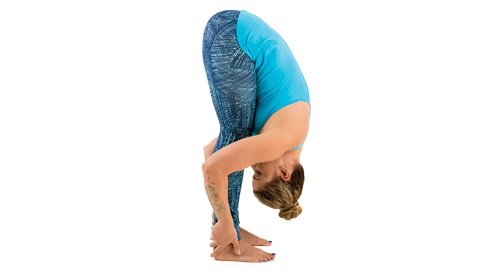
-
Ardha Uttanasana (Half Forward Bend Pose) - INHALE: Lengthen your spine and look forward, keeping your back flat.
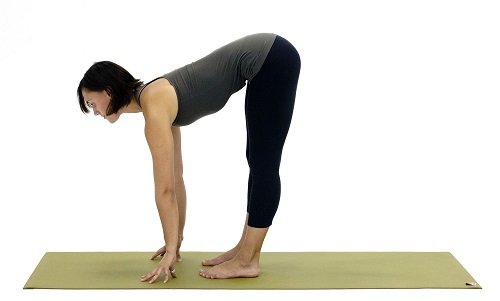
-
Chaturanga Dandasana - EXHALE: Step or jump back into a low plank, keeping your elbows close to your body.
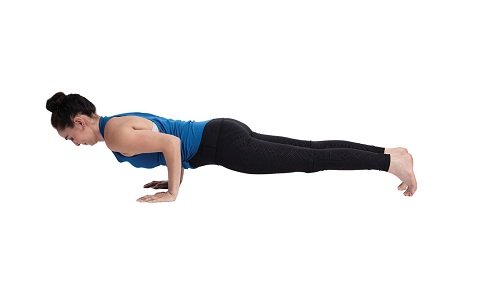
-
Urdhva Mukha Svanasana (Upward-Facing Dog) - INHALE: Roll over your toes, open your chest, and straighten your arms, lifting your thighs off the floor.
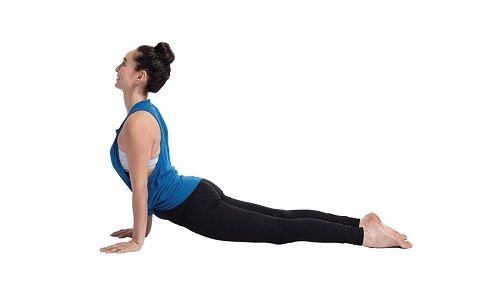
-
Adho Mukha Svanasana (Downward-Facing Dog) - EXHALE: Lift your hips up and back. Hold here for 5 deep breaths.

- Ardha Uttanasana (Half Lift) - INHALE: At the end of the fifth exhale, step or jump your feet forward between your hands and lift your chest halfway.
- Uttanasana (Forward Fold) - EXHALE: Fold forward completely over your legs.
- Urdhva Hastasana (Raised Arms Pose) - INHALE: Rise up with a flat back, sweeping your arms overhead to join the palms.
- Samasthiti (Equal Standing) - EXHALE: Return your hands to your heart center or by your sides.
Watch the Full Sequence
Tips for a Mindful Practice
- Practice in the early morning facing east to honor the rising sun.
- Always let your breath guide the movement, not the other way around.
- Keep your transitions smooth and avoid rushing between poses.
- Modify as needed. It's okay to step instead of jumping or to bend your knees in forward folds.
- After your final round, pause in Samasthiti to feel the warmth and energy you've cultivated.
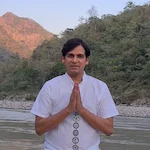
About the Author: Yogi Sandeep
Born in Rishikesh into a traditional family where the Vedic tradition has been a way of life for generations, Yogi Sandeep is the founder of Raj Yoga Rishikesh. He is an E-RYT 500 Teacher, holds a Master's degree in Yoga, and has over a decade of teaching experience.
Ashtanga Sun Salutation A FAQs
How many times should I practice Surya Namaskara A?
Traditionally, five rounds are practiced at the beginning of every Ashtanga Yoga session, often followed by five rounds of Surya Namaskara B.
What’s the difference between this and other Sun Salutations?
The Ashtanga version is a specific, set sequence that includes Chaturanga Dandasana and a five-breath hold in Downward-Facing Dog. Other styles may have different poses or omit the long hold.
Can beginners do this practice?
Yes, absolutely. Beginners should start slowly, focusing on learning the alignment and breath count. It's perfectly fine to modify by stepping back instead of jumping and bending the knees to protect the lower back.
Build Your Foundation in Ashtanga
Surya Namaskara A is the heartbeat of Ashtanga Yoga. Learn to master it with authentic guidance in our in-person and online Yoga Teacher Training programs from the birthplace of yoga.
Explore Our Trainings →
